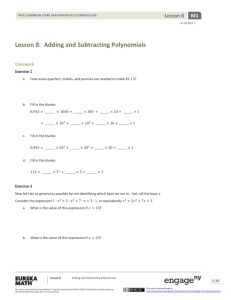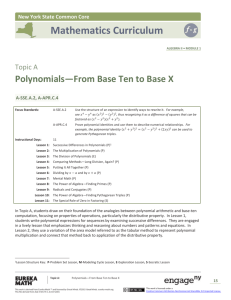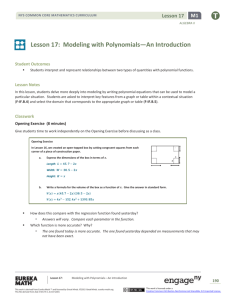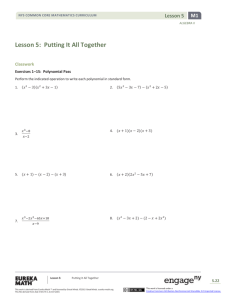Algebra II: Polynomial Long Division Lesson Plan
advertisement
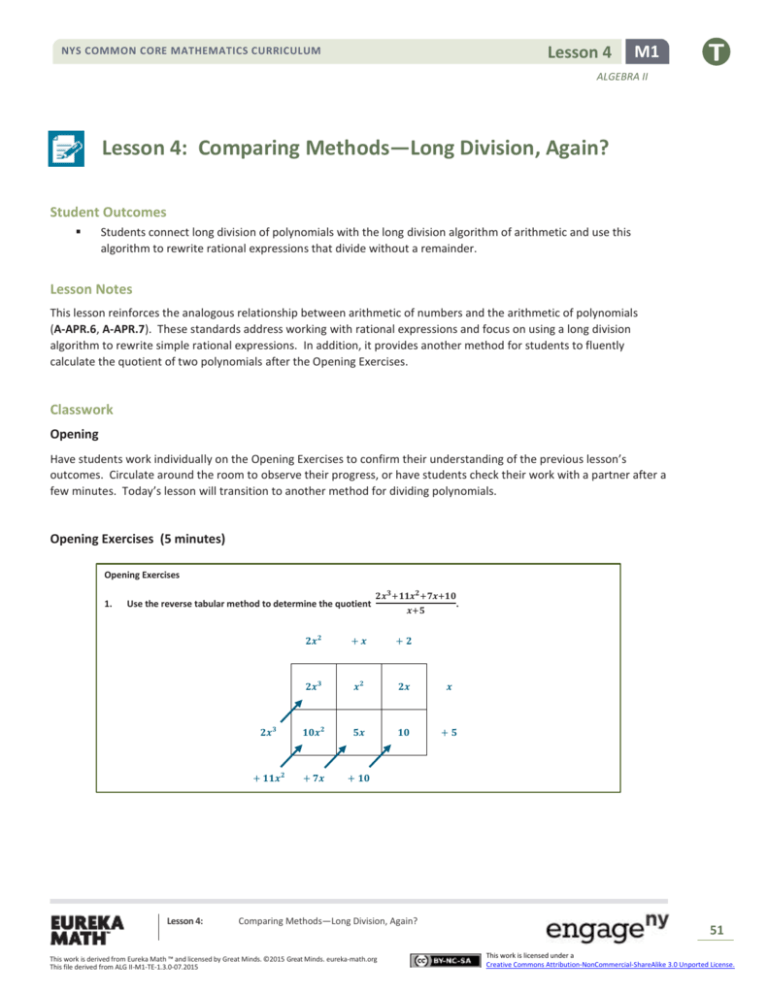
Lesson 4 NYS COMMON CORE MATHEMATICS CURRICULUM M1 ALGEBRA II Lesson 4: Comparing Methods—Long Division, Again? Student Outcomes Students connect long division of polynomials with the long division algorithm of arithmetic and use this algorithm to rewrite rational expressions that divide without a remainder. Lesson Notes This lesson reinforces the analogous relationship between arithmetic of numbers and the arithmetic of polynomials (A-APR.6, A-APR.7). These standards address working with rational expressions and focus on using a long division algorithm to rewrite simple rational expressions. In addition, it provides another method for students to fluently calculate the quotient of two polynomials after the Opening Exercises. Classwork Opening Have students work individually on the Opening Exercises to confirm their understanding of the previous lesson’s outcomes. Circulate around the room to observe their progress, or have students check their work with a partner after a few minutes. Today’s lesson will transition to another method for dividing polynomials. Opening Exercises (5 minutes) Opening Exercises 1. Use the reverse tabular method to determine the quotient Lesson 4: 𝟐𝒙𝟑 +𝟏𝟏𝒙𝟐 +𝟕𝒙+𝟏𝟎 . 𝒙+𝟓 𝟐𝒙𝟐 +𝒙 +𝟐 𝟐𝒙𝟑 𝒙𝟐 𝟐𝒙 𝒙 𝟐𝒙𝟑 𝟏𝟎𝒙𝟐 𝟓𝒙 𝟏𝟎 +𝟓 + 𝟏𝟏𝒙𝟐 + 𝟕𝒙 + 𝟏𝟎 Comparing Methods—Long Division, Again? This work is derived from Eureka Math ™ and licensed by Great Minds. ©2015 Great Minds. eureka-math.org This file derived from ALG II-M1-TE-1.3.0-07.2015 51 This work is licensed under a Creative Commons Attribution-NonCommercial-ShareAlike 3.0 Unported License. Lesson 4 NYS COMMON CORE MATHEMATICS CURRICULUM M1 ALGEBRA II Use your work from Exercise 1 to write the polynomial 𝟐𝒙𝟑 + 𝟏𝟏𝒙𝟐 + 𝟕𝒙 + 𝟏𝟎 in factored form, and then multiply the factors to check your work above. 2. (𝒙 + 𝟓)(𝟐𝒙𝟐 + 𝒙 + 𝟐) 𝟐𝒙𝟐 +𝒙 +𝟐 𝟐𝒙𝟑 𝒙𝟐 𝟐𝒙 𝒙 𝟐𝒙𝟑 𝟏𝟎𝒙𝟐 𝟓𝒙 𝟏𝟎 +𝟓 𝟏𝟏𝒙𝟐 𝟕𝒙 𝟏𝟎 The product is 𝟐𝒙𝟑 + 𝟏𝟏𝒙𝟐 + 𝟕𝒙 + 𝟏𝟎. Division and multiplication of polynomials are very similar to those operations with real numbers. In these problems, if 𝑥 = 10, the result would match an arithmetic problem. Yesterday, students divided two polynomials using the reverse tabular method. Today, the goal is to see how polynomial division is related to the long division algorithm learned in elementary school. Discussion (5 minutes) We have seen how division of polynomials relates to multiplication and that both of these operations are similar to the arithmetic operations you learned in elementary school. Can we relate division of polynomials to the long division algorithm? We would need to use the fact that the terms of a polynomial expression represent place value when 𝑥 = 10. Prompt students to consider the long division algorithm they learned in elementary school, and ask them to apply it to evaluate 1573 ÷ 13. Have a student model the algorithm on the board as well. The solution to this problem is included in the example below. Example 1 (5 minutes): The Long Division Algorithm for Polynomial Division When solving the problem in Example 1, be sure to record the polynomial division problem next to the arithmetic problem already on the board. Guide students through this example to demonstrate the parallels between the long MP.7 division algorithm for numbers and this method. Emphasize that the long division algorithm they learned in elementary school is a special case of polynomial long division. They should record the steps on their handouts or in their notebooks. Have students check their work by solving this problem using the reverse tabular method. Use the questions below while working the example. See the sample problem written out after Example 1, and use the questions that follow as discussion points while modeling this algorithm. Lesson 4: Comparing Methods—Long Division, Again? This work is derived from Eureka Math ™ and licensed by Great Minds. ©2015 Great Minds. eureka-math.org This file derived from ALG II-M1-TE-1.3.0-07.2015 52 This work is licensed under a Creative Commons Attribution-NonCommercial-ShareAlike 3.0 Unported License. Lesson 4 NYS COMMON CORE MATHEMATICS CURRICULUM M1 ALGEBRA II 𝑥2 When you do long division, you multiply the first digit of the quotient by the divisor and then subtract the result. It works the same with polynomial division. How do we represent multiplication and subtraction of polynomials? Scaffolding: What expression multiplied by 𝑥 will result in 𝑥 3 ? You apply the distributive property to multiply, and to subtract you add the opposite. Then, we repeat the process to determine the next term in the quotient. What do we need to bring down to complete the process? You should bring down the next term. Example 1 If 𝒙 = 𝟏𝟎, then the division 𝟏𝟓𝟕𝟑 ÷ 𝟏𝟑 can be represented using polynomial division. x 3 x 3 5x 2 7 x 3 The quotient is 𝒙𝟐 + 𝟐𝒙 + 𝟏. The completed board work for this example should look something like this: Example 2 (5 minutes): The Long Division Algorithm for Polynomial Division For further scaffolding, consider starting with a simpler problem, such as 126 ÷ 18. Have students compare this problem to the polynomial division problem (𝑥 2 + 2𝑥 + 6) ÷ (𝑥 + 8) by explaining the structural similarities. Have students consider this as the teacher places them side by side on the board. This shows students that if 𝑥 = 10, the polynomial division problem is analogous to the integer division problem. For advanced learners, challenge them to create two examples, a numerical one and a polynomial one, that illustrate the structural similarities. Note, however, that not every problem will work nicely. For example, 800 ÷ 32 = 25, but 8𝑥 2 ÷ (3𝑥 + 2) ≠ 2𝑥 + 5 because there are many polynomials in 𝑥 that evaluate to 25 when 𝑥 = 10. Any two numbers can be divided as long as the divisor is not equal to 0. Similarly, any two polynomials can be divided as long as the divisor is not equal to 0. Note: The number 0 is also a polynomial. Because the class is now dealing with a general case of polynomials and not simply numbers, it is possible to solve problems where the coefficients of the terms are any real numbers. It would be difficult, but not impossible, if the coefficients of the terms of the polynomials were irrational. In the next example, model again how this process works. Be sure to point out that students must use a 0 coefficient place holder for the missing 𝑥 term. Example 2 Use the long division algorithm for polynomials to evaluate 𝟐𝒙𝟑 − 𝟒𝒙𝟐 + 𝟐 𝟐𝒙 − 𝟐 The quotient is 𝒙𝟐 − 𝒙 − 𝟏. Lesson 4: Comparing Methods—Long Division, Again? This work is derived from Eureka Math ™ and licensed by Great Minds. ©2015 Great Minds. eureka-math.org This file derived from ALG II-M1-TE-1.3.0-07.2015 53 This work is licensed under a Creative Commons Attribution-NonCommercial-ShareAlike 3.0 Unported License. NYS COMMON CORE MATHEMATICS CURRICULUM Lesson 4 M1 ALGEBRA II Before beginning the next exercises, take the time to reinforce the idea that polynomial division is analogous to whole number division by posing a reflection question. Students can discuss this with a partner or respond in writing. Why are we able to do long division with polynomials? Polynomials form a system analogous to the integers. The same operations that hold for integers hold for polynomials. Exercises 1–8 (15 minutes) These problems start simple and become more complicated. Monitor student progress as they work. Have students work these problems independently or in pairs, and use this as an opportunity to informally assess their understanding. After students have completed the exercises, post the solutions on the board but not the work. Have students with errors team up with a partner and trade papers. Ask students to find the mistakes in their partner’s work. Choose an incorrect solution to display on the board, and then lead a class discussion to point out where students are likely to make errors and how to prevent them. Students typically make careless errors in multiplying or subtracting terms. Other errors can occur if they forget to include the zero coefficient place holder terms when needed. If students appear to be running short on time, have them check every other result using the reverse tabular method. Alternately, students could check their work using multiplication. Exercises 1–8 Use the long division algorithm to determine the quotient. For each problem, check your work by using the reverse tabular method. 1. 𝒙𝟐 +𝟔𝒙+𝟗 𝒙+𝟑 𝒙+𝟑 2. 𝟕𝒙𝟑 −𝟖𝒙𝟐 −𝟏𝟑𝒙+𝟐 𝟕𝒙−𝟏 𝟐 𝒙 −𝒙−𝟐 3. 𝒙𝟑 −𝟐𝟕 𝒙−𝟑 𝒙𝟐 + 𝟑𝒙 + 𝟗 4. 𝟐𝒙𝟒 +𝟏𝟒𝒙𝟑 +𝒙𝟐 −𝟐𝟏𝒙−𝟔 𝟐𝒙𝟐 −𝟑 𝟐 𝒙 + 𝟕𝒙 + 𝟐 5. 𝟓𝒙𝟒 −𝟔𝒙𝟐 +𝟏 𝒙𝟐 −𝟏 𝟐 𝟓𝒙 − 𝟏 Lesson 4: Comparing Methods—Long Division, Again? This work is derived from Eureka Math ™ and licensed by Great Minds. ©2015 Great Minds. eureka-math.org This file derived from ALG II-M1-TE-1.3.0-07.2015 54 This work is licensed under a Creative Commons Attribution-NonCommercial-ShareAlike 3.0 Unported License. Lesson 4 NYS COMMON CORE MATHEMATICS CURRICULUM M1 ALGEBRA II 𝒙𝟔 +𝟒𝒙𝟒 −𝟒𝒙−𝟏 6. 𝒙𝟑 −𝟏 𝟑 𝒙 + 𝟒𝒙 + 𝟏 𝟐𝒙𝟕 +𝒙𝟓 −𝟒𝒙𝟑 +𝟏𝟒𝒙𝟐 −𝟐𝒙+𝟕 7. 𝟐𝒙𝟐 +𝟏 𝟓 𝒙 − 𝟐𝒙 + 𝟕 𝒙𝟔 −𝟔𝟒 8. 𝒙+𝟐 𝒙𝟓 − 𝟐𝒙𝟒 + 𝟒𝒙𝟑 − 𝟖𝒙𝟐 + 𝟏𝟔𝒙 − 𝟑𝟐 Closing (5 minutes) Ask students to summarize the important parts of this lesson either in writing, to a partner, or as a class. Use this opportunity to informally assess their understanding prior to starting the Exit Ticket. Important elements are included in the Lesson Summary box below. The questions that follow are recommended to guide the discussions with sample student responses included in italics. Depending on the structure of the closure activity, the sample responses would be similar to student-written, partner, or whole-class summaries. Which method do you prefer, long division or the reverse tabular method? Is one method easier than another? Student responses will vary. The reverse tabular method may appeal to visual learners. The long division algorithm works well as long as you avoid careless mistakes. This will depend on student preferences, but some will like the connection to prior methods for dividing and multiplying. Perhaps when many terms are missing (as in Exercise 8), the reverse tabular method can go more quickly than long division. What advice would you give to a friend that is just learning how to do these problems quickly and accurately? Be careful when multiplying terms and working with negative terms. Lesson Summary The long division algorithm to divide polynomials is analogous to the long division algorithm for integers. The long division algorithm to divide polynomials produces the same results as the reverse tabular method. Exit Ticket (5 minutes) Lesson 4: Comparing Methods—Long Division, Again? This work is derived from Eureka Math ™ and licensed by Great Minds. ©2015 Great Minds. eureka-math.org This file derived from ALG II-M1-TE-1.3.0-07.2015 55 This work is licensed under a Creative Commons Attribution-NonCommercial-ShareAlike 3.0 Unported License. Lesson 4 NYS COMMON CORE MATHEMATICS CURRICULUM M1 ALGEBRA II Name Date Lesson 4: Comparing Methods—Long Division, Again? Exit Ticket Write a note to a friend explaining how to use long division to find the quotient. 2𝑥 2 − 3𝑥 − 5 𝑥+1 Lesson 4: Comparing Methods—Long Division, Again? This work is derived from Eureka Math ™ and licensed by Great Minds. ©2015 Great Minds. eureka-math.org This file derived from ALG II-M1-TE-1.3.0-07.2015 56 This work is licensed under a Creative Commons Attribution-NonCommercial-ShareAlike 3.0 Unported License. Lesson 4 NYS COMMON CORE MATHEMATICS CURRICULUM M1 ALGEBRA II Exit Ticket Sample Solutions Write a note to a friend explaining how to use long division to find the quotient. 𝟐𝒙𝟐 − 𝟑𝒙 − 𝟓 𝒙+𝟏 Set up the divisor outside the division symbol and the dividend underneath it. Then ask yourself what number multiplied by 𝒙 is 𝟐𝒙𝟐 . Then multiply that number by 𝒙 + 𝟏, and record the results underneath 𝟐𝒙𝟐 − 𝟑𝒙. Subtract these terms and bring down the −𝟓. Then repeat the process. Problem Set Sample Solutions Use the long division algorithm to determine the quotient in problems 1–5. 1. 𝟐𝒙𝟑 −𝟏𝟑𝒙𝟐 −𝒙+𝟑 𝟐𝒙+𝟏 𝟐 𝒙 − 𝟕𝒙 + 𝟑 2. 𝟑𝒙𝟑 +𝟒𝒙𝟐 +𝟕𝒙+𝟐𝟐 𝒙+𝟐 𝟐 𝟑𝒙 − 𝟐𝒙 + 𝟏𝟏 3. 𝒙𝟒 +𝟔𝒙𝟑 −𝟕𝒙𝟐 −𝟐𝟒𝒙+𝟏𝟐 𝒙𝟐 −𝟒 𝒙𝟐 + 𝟔𝒙 − 𝟑 4. (𝟏𝟐𝒙𝟒 + 𝟐𝒙𝟑 + 𝒙 − 𝟑) ÷ (𝟐𝒙𝟐 + 𝟏) 𝟔𝒙𝟐 + 𝒙 − 𝟑 5. (𝟐𝒙𝟑 + 𝟐𝒙𝟐 + 𝟐𝒙) ÷ (𝒙𝟐 + 𝒙 + 𝟏) 𝟐𝒙 6. Use long division to find the polynomial, 𝒑, that satisfies the equation below. 𝟐𝒙𝟒 − 𝟑𝒙𝟐 − 𝟐 = (𝟐𝒙𝟐 + 𝟏)(𝒑(𝒙)) 𝒑(𝒙) = 𝒙𝟐 − 𝟐 7. Given 𝒒(𝒙) = 𝟑𝒙𝟑 − 𝟒𝒙𝟐 + 𝟓𝒙 + 𝒌. a. Determine the value of 𝒌 so that 𝟑𝒙 − 𝟕 is a factor of the polynomial 𝒒. 𝒌 = −𝟐𝟖 b. What is the quotient when you divide the polynomial 𝒒 by 𝟑𝒙 − 𝟕? 𝒙𝟐 + 𝒙 + 𝟒 Lesson 4: Comparing Methods—Long Division, Again? This work is derived from Eureka Math ™ and licensed by Great Minds. ©2015 Great Minds. eureka-math.org This file derived from ALG II-M1-TE-1.3.0-07.2015 57 This work is licensed under a Creative Commons Attribution-NonCommercial-ShareAlike 3.0 Unported License. Lesson 4 NYS COMMON CORE MATHEMATICS CURRICULUM M1 ALGEBRA II 8. In parts (a)–(b) and (d)–(e), use long division to evaluate each quotient. Then, answer the remaining questions. a. 𝒙𝟐 −𝟗 𝒙+𝟑 𝒙−𝟑 b. 𝒙𝟒 −𝟖𝟏 𝒙+𝟑 𝒙𝟑 − 𝟑𝒙𝟐 + 𝟗𝒙 − 𝟐𝟕 c. Is 𝒙 + 𝟑 a factor of 𝒙𝟑 − 𝟐𝟕? Explain your answer using the long division algorithm. No. The remainder is not 𝟎 when you perform long division. d. MP.2 & MP.8 𝒙𝟑 +𝟐𝟕 𝒙+𝟑 𝒙𝟐 − 𝟑𝒙 + 𝟗 e. 𝒙𝟓 +𝟐𝟒𝟑 𝒙+𝟑 𝟒 𝒙 − 𝟑𝒙𝟑 + 𝟗𝒙𝟐 − 𝟐𝟕𝒙 + 𝟖𝟏 f. Is 𝒙 + 𝟑 a factor of 𝒙𝟐 + 𝟗? Explain your answer using the long division algorithm. No. The remainder is not 𝟎 when you perform long division. g. For which positive integers 𝒏 is 𝒙 + 𝟑 a factor of 𝒙𝒏 + 𝟑𝒏 ? Explain your reasoning. Only if 𝒏 is an odd number. By extending the patterns in parts (a)–(c) and (e), we can generalize that 𝒙 + 𝟑 divides evenly into 𝒙𝒏 + 𝟑𝒏 for odd powers of 𝒏 only. h. If 𝒏 is a positive integer, is 𝒙 + 𝟑 a factor of 𝒙𝒏 − 𝟑𝒏 ? Explain your reasoning. Only for even numbers 𝒏. By extending the patterns in parts (a)–(c), we can generalize that 𝒙 + 𝟑 will always divide evenly into the dividend. Lesson 4: Comparing Methods—Long Division, Again? This work is derived from Eureka Math ™ and licensed by Great Minds. ©2015 Great Minds. eureka-math.org This file derived from ALG II-M1-TE-1.3.0-07.2015 58 This work is licensed under a Creative Commons Attribution-NonCommercial-ShareAlike 3.0 Unported License.

